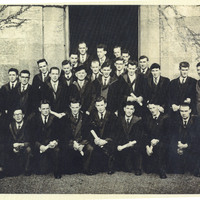PRENDERGAST, William Hillary
Item
Title
Identifier
firstName
familyName
Known as
Bio-note
Biography
Professor Prendergast’s role on the railways in Burma (Myanmar) is extensively covered in Michael W. Charney, Imperial Military Transportation in British Asia: Burma 1941–1942 (London, 2019).
The following obituary was published by the Institution of Civil Engineers (ICE) in its Proceedings in March 1958.
'PROFESSOR WILLIAM HILARY PRENDERGAST, D.S.O., B.E., BSc., who was born in Athlone, Co. Westmeath, on 13 January, 1895, died in Galway on 22 July, 1957.
Educated at St Ignatius’ College, Galway, he graduated in engineering and science with first class honours, at University College, Galway, in 1915.
He was an Assistant, for a year, to the late P. H. McCarthy, M.A., B.A.I., M.I.C.E.I., an eminent Dublin Consulting Engineer. In 1916 he obtained his commission with the Royal Engineers, was engaged on various projects at Basra and Lake Hammar, and retired at the end of the 1914-18 war with the rank of Major.
In 1919 he was appointed Assistant Irrigation Officer, Mesopotamia, and the following year he joined the Bengal-Assam Railway with which he spent most of his subsequent career until he retired in 1947.
During that 27 years, his engineering activities covered the wide field of project, design, organization, and execution of very important new work as well as the normal routine of maintenance of permanent way, stations and all ancillary services.
One of the outstanding features of his career during this period was, however, that in addition to his normal professional work he was assigned to investigate, report on, and apply to the organization of his own railway, the type of organization and operation methods used on railways in Britain. This important research work took him to the Derby laboratory of the London, Midland and Scottish Railway for 6 months in 1939. Prior to this he had been on special duty in implementing the recommendations of the Wedgewood Committee Report on Indian Railways. The reorganization of the Bengal-Assam Railways resulted from this work. He was, in 1938, appointed Deputy General Manager (Organization) to his Company.
In 1940 he was lent to the British Army and served with the Indian Engineers; he trained a number of Railway Construction Companies and was promoted to the rank of Lieutenant-Colonel. He planned and began the construction of the doubling of 150 miles of the railway line from Basra to Baghdad.
Some little time before the Japanese invasion he was posted to Burma to assist the civil railway administration and was mainly responsible for organizing the evacuation of the “last ditchers” from Rangoon but a few days before its fall.
An especially meritorious action, under fire, and his leadership of hundreds of men after their trains had to be abandoned, earned him the Distinguished Service Order. He was also twice Mentioned in Dispatches.
He was next appointed Assistant Director of Transportation G.H.Q. and his work included advising on harbour developments at Karachi and Bombay, and technical training for railway, surveying, bridging, and maintenance units.
When the Japanese were advancing on India he was made Engineer-in-Chief (Railway Construction) on the Assam lines of communication. His work on this assignment included the doubling of 117 miles of track, heavy bridge and earthwork construction, provision of workers’ and staff dwellings, water supplies, workshops, and marshalling yards, while the capacity of the rail ferry across the Brahmaputra was rapidly increased from 300 to 850 wagons per day each way.
On the conclusion of the war with Japan he returned to the Bengal-Assam Railway as Deputy Chief Engineer, retired in 1947, returned to Ireland, and was appointed to the Chair of Engineering in University College, Galway. This post he held with great distinction and success until his untimely death.
In addition to his very considerable attainments as an engineer and professor, he possessed a wide range of knowledge in the arts, culture, and the humanities.
Elected an Associate Member in 1924, he was transferred to the class of Members in 1936.
He was Senior Vice-President of the Institution of Civil Engineers of Ireland, President of the Engineers’ Association, and a Member of the Institute of Transport.
He is survived by his widow and sister.' ('Obituary')
References
Michael W. Charney, Imperial Military Transportation in British Asia: Burma 1941–1942 (London, 2019).
Paul Duffy 'Engineering' in Tadhg Foley (ed.), From Queen’s College to National University (Dublin, 1999), pp 130, 135-6.
'Obituary: Professor William Hilary Prendergast, DSO, 1895-1957', Proceedings of the Institution of Civil Engineers, 9:3 (March 1958), 342-343, https://doi.org/10.1680/iicep.1958.2301, accessed 2023.06.22.
Bibliographic Citation
Key Words
Language
Publisher
Date Modified
Note
Research by: Jane Conroy.
lastReviewed
Linked resources
Filter by property
| Title | Alternate label | Class |
|---|---|---|
 Engineering Graduate Class, 1956 Engineering Graduate Class, 1956 |
People | Image |
